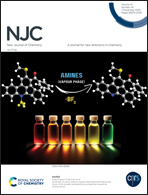Synthesis, optical properties and conduction mechanism study of α- and γ-NaMnO2 materials†
Abstract
Herein, NaMnO2 cathode active materials, in both α- and γ-phases, were synthesized via a solid–solid method. Powder X-ray diffraction analysis revealed that these compounds crystallize in a monoclinic system with the C2/m space group and orthorhombic system with the Pnmm space group for the α- and γ-phases, respectively. Raman spectroscopy showed the presence of the MnO6 octahedral group in the α-phase, and the MnO4 tetrahedral group in the γ-phase. The direct band gap (Eg) was calculated to 4.96 eV and 5.14 eV for the α- and γ-phases, respectively, confirming that α-NaMnO2 has better electronic conductivity than γ-NaMnO2. The Urbach energy values, Eu, show that the octahedral α-phase is more disordered than the tetrahedral γ-phase in the NaMnO2 material. The electrical data analysis of the impedance spectra and the imaginary part of the complex modulus showed the presence of two types of relaxations, corresponding to grain and grain boundary effects in both compounds. The thermal evolution of the relaxation time and DC conductivity followed the Arrhenius law with a change in the activation energy at around Tα = 363 K for the α-phase and Tγ = 373 K for the γ-phase. In addition, the frequency behaviour of the AC conductivity, σac, of these two samples was analyzed using the universal Jonscher law. Therefore, the variation in sg for both compounds with temperature showed a change in the conduction mechanism at around Tα and Tγ for the α- and γ-phases, respectively.



 Please wait while we load your content...
Please wait while we load your content...